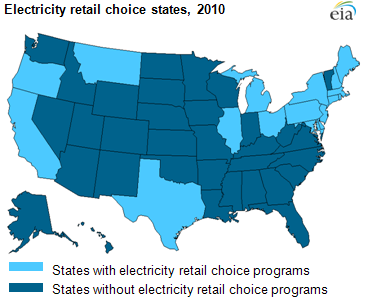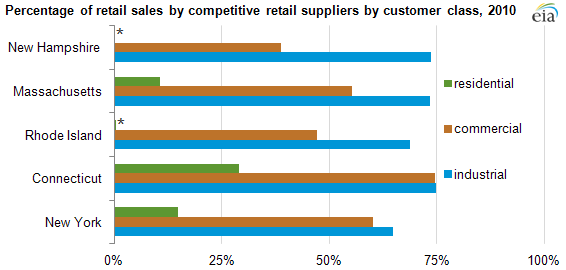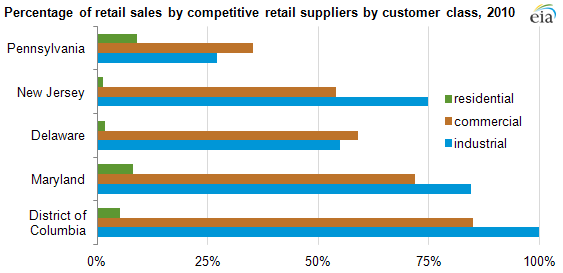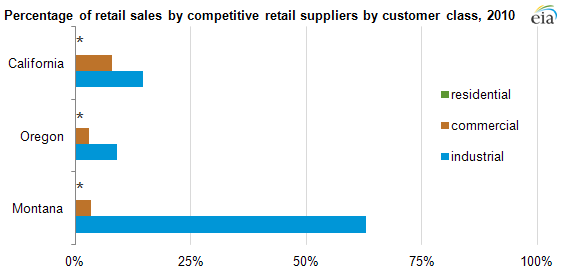
State electric retail choice programs are popular with commercial and industrial customers

Seventeen states and the District of Columbia have adopted electric retail choice programs that allow end-use customers to buy electricity from competitive retail suppliers. While residential customer participation rates are low in almost all of these states, a majority of commercial customers have signed up with competitive suppliers in 9 states and a majority of industrial customers have signed up in 12 states. The highest participation rates are found in the Northeast, Mid-Atlantic states, and Texas where electricity is supplied through Regional Transmission Organizations (RTOs) and states have unbundled generation from retail delivery and sales.
Below are state-by-state percentages of residential, commercial, and industrial sales volumes by competitive suppliers for 2010 (the most recent data available from the Form EIA-861 survey). Overall, competitive retail suppliers provided 16% of total U.S. retail sales by volume in 2010.
Retail sales for Texas are not shown below since participation is mandated for all customers served by investor-owned utilities located within the ERCOT region that covers much of the state. Participation is not mandated for municipal and cooperative utilities within ERCOT. About 60% of residential, commercial, and industrial customers in Texas buy electricity from competitive suppliers.

Note: *Denotes less than 1% of sales in a customer class.
Download CSV Data
Northeastern States: In five states in the Northeast, 65% to 75% of industrial customers buy directly from competitive suppliers. Except in Connecticut, the participation rate for the commercial sector is significantly lower than the industrial sector. Connecticut has the highest residential sector participation rate outside of Texas at 29%. Connecticut's Energy Information Center provides easy-to-use price comparisons for utility and competitive supplier service.
Maine is not included even though it is a retail choice state because reporting issues prevent calculation of these percentages. Vermont does not have retail choice.

Download CSV Data
Mid-Atlantic States: The District of Columbia's only industrial customer participates in a retail choice program. Maryland has the third-highest share (84%) of electric provided by competitive retail suppliers among Mid-Atlantic states. The industrial and commercial sector competitive supply participation rates in Delaware and New Jersey are above 50%.

Note: *Denotes less than 1% of sales in a customer class.
Download CSV Data
Midwestern States: Only three states in the Midwest have adopted retail choice programs. Illinois' industrial and commercial participation rates are among the highest in the country, at 85% and 56%, respectively. Ohio's residential sector participation rate at 19% is the third highest in the country after Connecticut and Texas.

Note: *Denotes less than 1% of sales in a customer class.
Download CSV Data
Western States: Other than the industrial sector in Montana with 63% participation, the participation rates in all sectors in the three Western retail choice states are small. As early as 2001, more than 50% of Montana's industrial sector sales were provided by competitive suppliers. All the competitive retail supply in California occurs in the area supplied by the California ISO, which is an RTO that serves most of the state. An RTO does not operate in the other two Western states.